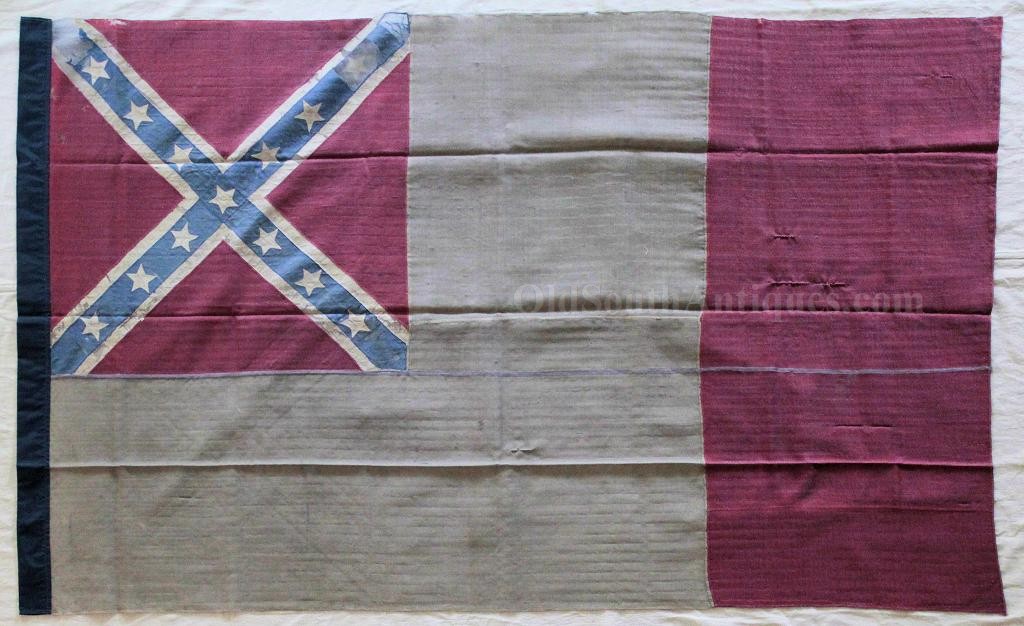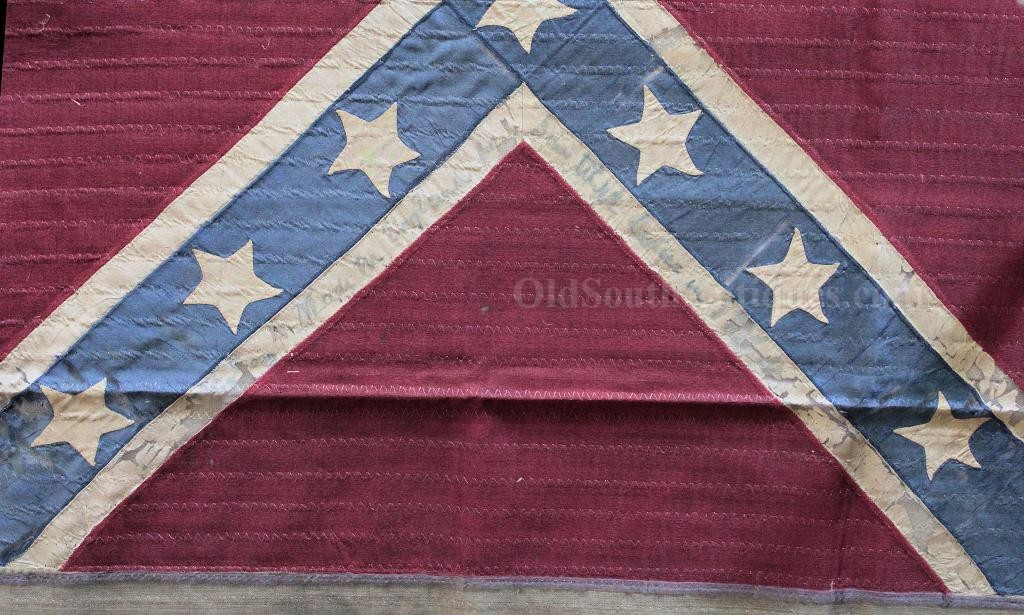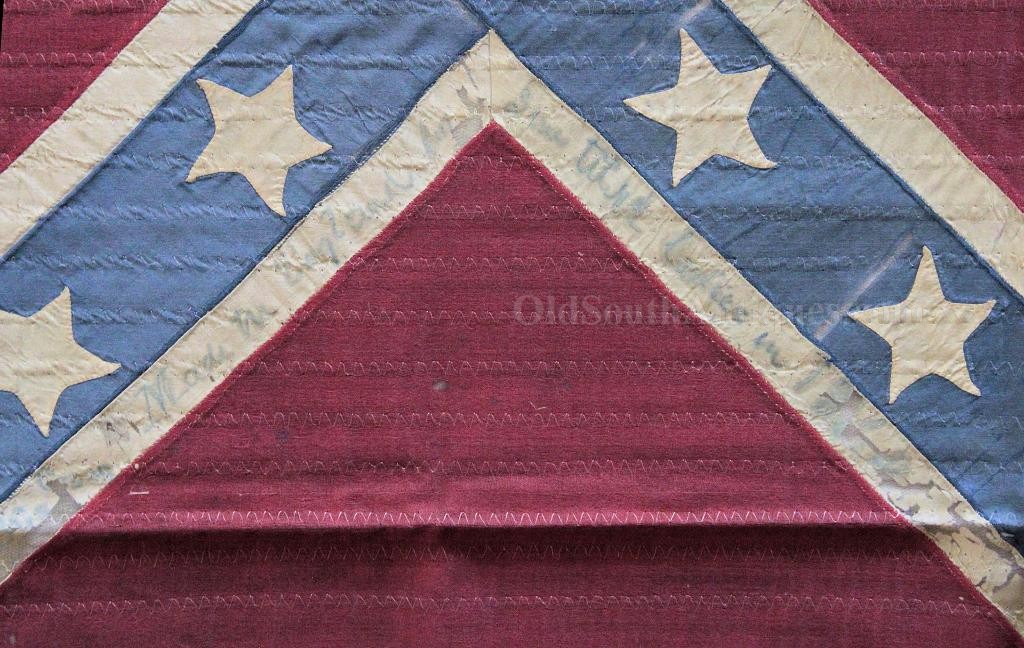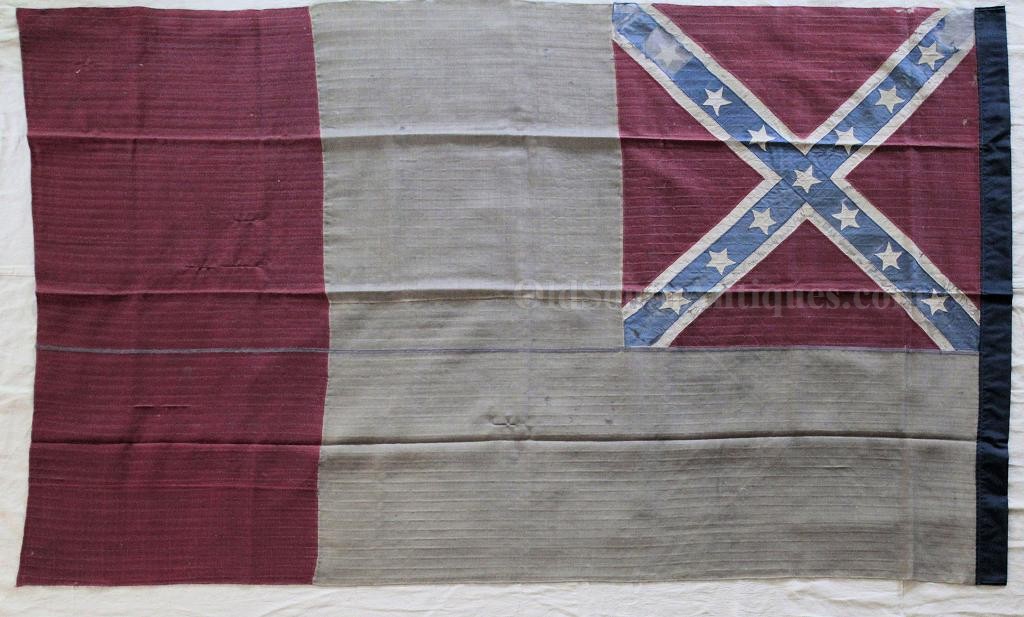
| Catalog | Past Items | Order Info | Terms/Conditions | About Us | Inventory Clearance |
The "Last National" flag was adopted by the Confederate Congress on March 4, 1865. Because of their late usage, there are very few authentic flags (seven known) and rarer yet are those identified to a specific military unit. There are four, including this one, the 5th Florida Battalion, 78th North Carolina Reserve, 18th Mississippi and the flag shown here of the Upson County Guards.
The inscription "UCo Grd’s Made in England by some titled Ladies in 1864” is written on the canton’s fimbration in blue pencil. This begs the question, how could an 1864 flag be in the Confederate Third National form since that pattern was not adopted by the Confederacy until it was created by an Act of the Congress of the Confederate States and approved by the President on the 4th day of March, 1865?
The Confederate Second National flag was adopted on May 1, 1863, and this flag was made by the "Titled Ladies” of England in 1864. We do not know what month the Upson Guards received the flag; it could have been any time in 1864, but we know that it was back near Upson County on April 20, 1865 in the form of a Third National Pattern when the 17th Indiana Infantry of Wilder’s Brigade captured it. On that date five Confederate flags along with Major General Howell Cobb, Brigadier General G.W. Smith, Brigadier General H.W. Mercer and Brigadier General W.W. Mackall, and 3500 of their men, 60 pieces of artillery and 3000 stand of arms were captured leading up to and at the fall of Macon, Georgia after the heavily outnumbered forces sent to stop them were routed.
Private William Carroll of the Upson County Guards was captured in Macon that day. Private Charles Collier was captured in skirmishing the day before. Collier had been discharged for disability in 1862, but apparently took up arms again in defense of his own neighborhood, so, either Private Carroll or Private Collier could have been carrying the flag.
Either way, while the Upson Guards were fighting in North Carolina under Joe Johnston, these two members were home and may have brought the flag with them to have the red bar placed upon it, as the law had only been changed sixteen days before. There is no way it could have been returned to Upson County, changed to a Third National and returned to North Carolina in those waning days of the Confederacy.
What we know for certain is this: The flag was made as a Second National Pattern by some titled Ladies in England for the Upson Guards. It was changed to a Third National Pattern sometime between its adoption on May 4, 1865 and that it was captured by the 17thIndiana Infantry on May 20, 1865 at or near Macon, Georgia, as reported by Colonel Frank White. Five days later Colonel White forwarded four of the flags to the AA General of the Second Division Cavalry Corps, U.S.A.
The Guards could have carried the flag for no more than 12 months. During these twelve months the Upson Guards of the 5th Georgia Infantry suffered through a series of battles as Sherman burned and pillaged his way through their home in 1864. They may have first received the flag as they withdrew through Upson County, helpless to protect their families from Sherman’s marauding horde. Then they were ordered to the South Carolina coast late that year, fighting to protect the Charleston and Savannah railroad, until overwhelmed and forced to retreat to the Army of Tennessee. The 5th continued the miserable retreat through the Carolina’s with the rest of the Confederate Army, surrendering with Joseph Johnston’s Army on April 26th. At the time, they were unaware that their treasured flag had been captured six days before.
The 71 by 43 inch flag comes with documentation of the notes and records of the Chicago Historical Museum, Charles F. Gunther Collection. The flag was conserved by Fonda Thomsen, Textile Preservation Association in1979, using the quilted stabiltex method, (which is fully reversible) so the flag can be easily handled and it is ready for framing. Josh Phillips of Heritage Conservation can remove the previous quilting and conserve it using less intrusive method at a reasonable cost should you so desire.
Copyright © 2025 OldSouthAntiques.com All Rights Reserved.
Privacy Policy | Terms of Use
Powered by Web-Cat Copyright © 1996-2025 GrayCat Systems



